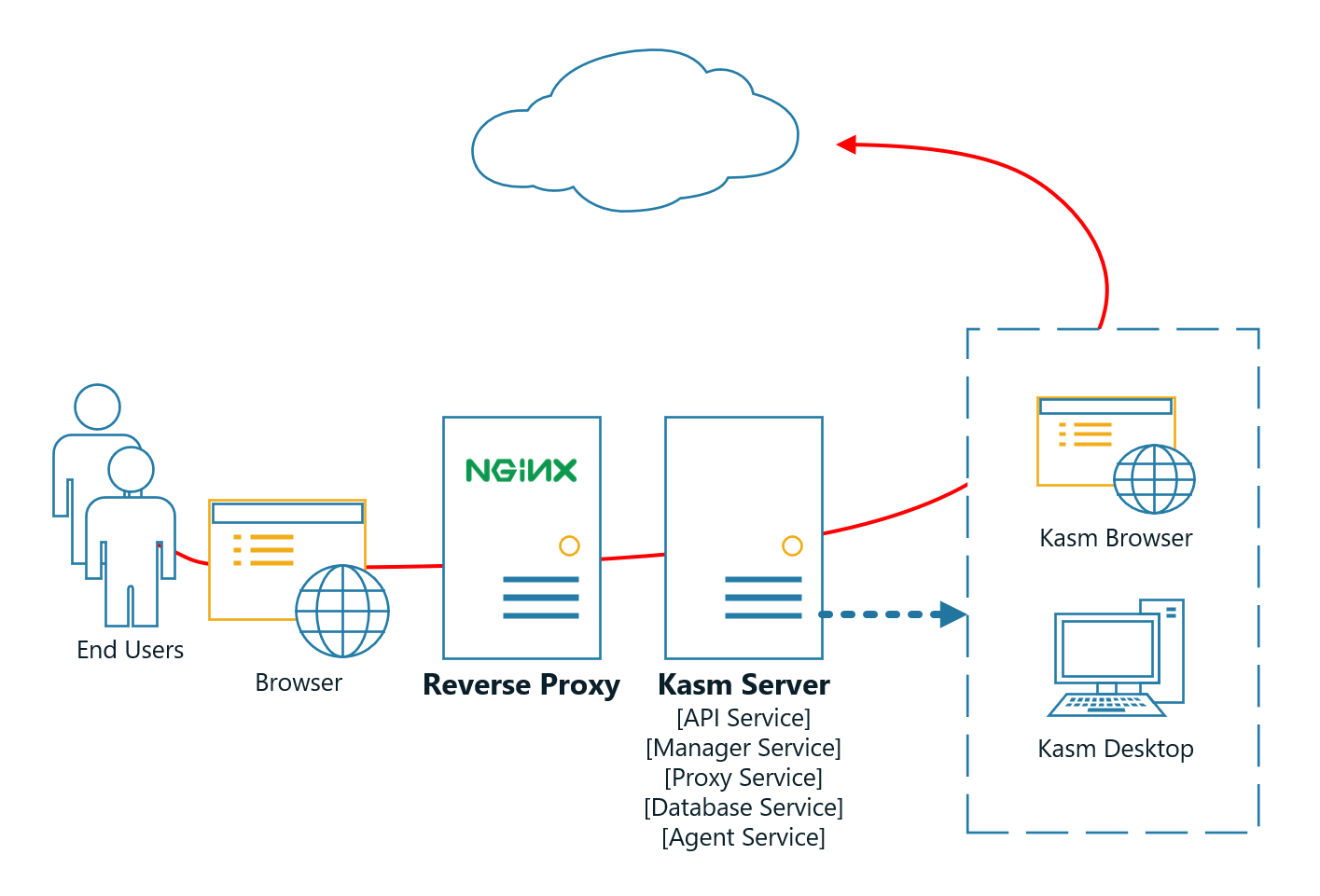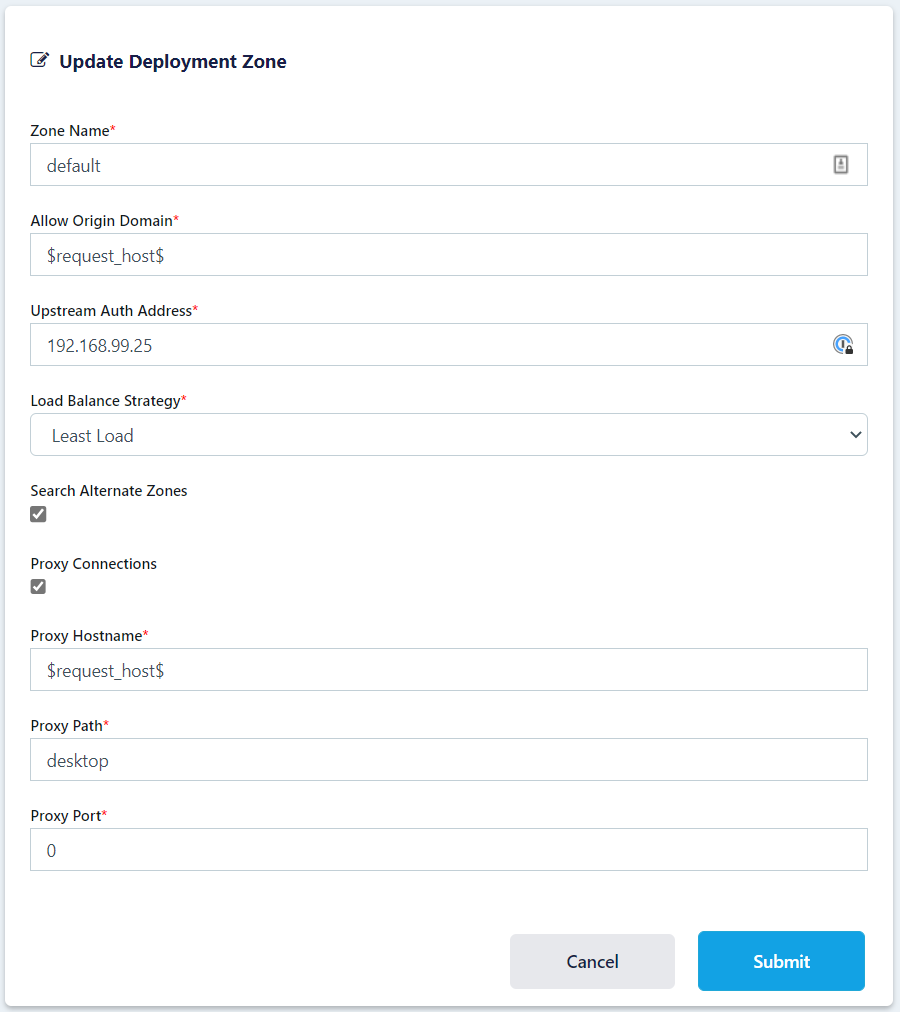Reverse Proxy¶
Overview¶
Administrators may desire to run Kasm Workspaces behind a reverse proxy such as Nginx or Caddy . A handful of configurations are required for communication to properly flow between the proxy and Kasm.
Important
Once Kasm is placed behind a reverse proxy, be sure to update the Zone configuration. See Update Zones.

Kasm Workspaces Behind a Reverse Proxy¶
Troubleshooting info can be found on the Troubleshooting Page
Running Kasm Workspaces on a Non-Standard Port¶
By default, Kasm Workspaces will listen on port 443. Administrators may wish to run the application on another port so that the reverse proxy can run on port 443.
During the installation pass the -L flag to choose a different port.
e.g sudo bash kasm_release/install.sh -L 8443
Users will now access Kasm Workspaces via the defined port https://kasm.server:8443
Example Nginx Config¶
Below is an example Nginx config with the appropriate settings for Kasm annotated. In this example, Nginx is listening on port 443 and Kasm Workspaces is listening on port 8443
server {
listen 443 ssl;
ssl_certificate /etc/nginx/ssl/nginx.crt;
ssl_certificate_key /etc/nginx/ssl/nginx.key;
location / {
# The following configurations must be configured when proxying to Kasm Workspaces
# WebSocket Support
proxy_set_header Upgrade $http_upgrade;
proxy_set_header Connection "upgrade";
# Host and X headers
proxy_set_header Host $host;
proxy_set_header X-Real-IP $remote_addr;
proxy_set_header X-Forwarded-For $proxy_add_x_forwarded_for;
proxy_set_header X-Forwarded-Proto $scheme;
# Connectivity Options
proxy_http_version 1.1;
proxy_read_timeout 1800s;
proxy_send_timeout 1800s;
proxy_connect_timeout 1800s;
proxy_buffering off;
# Allow large requests to support file uploads to sessions
client_max_body_size 10M;
# Proxy to Kasm Workspaces running locally on 8443 using ssl
proxy_pass https://127.0.0.1:8443 ;
}
}
Multiple Server Names¶
Kasm Workspaces does not support being proxied to using alternate paths, (e.g https://example.com/kasm/). If
Administrators desire to run multiple applications behind Nginx, it is recommended to use a dedicated server_name
for traffic destined for Kasm. (e.g https://kasm.example.com/). See
Nginx Server Names documentation for more details.
server {
listen 443 ssl;
server_name app1.example.com;
ssl_certificate /etc/nginx/ssl/nginx.crt;
ssl_certificate_key /etc/nginx/ssl/nginx.key;
location / {
return 200 'App 1';
add_header Content-Type text/plain;
}
}
server {
listen 443 ssl;
server_name kasm.example.com;
ssl_certificate /etc/nginx/ssl/nginx.crt;
ssl_certificate_key /etc/nginx/ssl/nginx.key;
location / {
# The following configurations must be configured when proxying to Kasm Workspaces
# WebSocket Support
proxy_set_header Upgrade $http_upgrade;
proxy_set_header Connection "upgrade";
# Host and X headers
proxy_set_header Host $host;
proxy_set_header X-Real-IP $remote_addr;
proxy_set_header X-Forwarded-For $proxy_add_x_forwarded_for;
proxy_set_header X-Forwarded-Proto $scheme;
# Connectivity Options
proxy_http_version 1.1;
proxy_read_timeout 1800s;
proxy_send_timeout 1800s;
proxy_connect_timeout 1800s;
proxy_buffering off;
# Allow large requests to support file uploads to sessions
client_max_body_size 10M;
# Proxy to Kasm Workspaces running locally on 8443 using ssl
proxy_pass https://127.0.0.1:8443 ;
}
}
Example Caddy Config¶
Below is an example Caddyfile with the appropriate settings for Kasm annotated. In this example Caddy is listening on port 443 and Kasm Workspaces is listening on port 8443
192.168.117.130:443
tls self_signed
log stdout
# Proxy to Kasm running locally on port 8443
proxy / https://localhost:8443 {
# By default Kasm Workspaces installs with self-signed certificates. If these are not replaced
# then Caddy must be instructed to skip verification of these certs.
insecure_skip_verify
# WebSocket Support
header_upstream Connection {>Connection}
header_upstream Upgrade {>Upgrade}
# Host and X headers
header_upstream Host {host}
header_upstream X-Real-IP {remote}
header_upstream X-Forwarded-For {remote}
header_upstream X-Forwarded-Port {server_port}
header_upstream X-Forwarded-Proto {scheme}
}
Example Caddy V2 Config¶
Below is an example V2 Caddyfile. In this example Caddy is listening on port 443 and Kasm Workspaces is listening on port 8443
{
local_certs
default_sni kasm.example.local
}
https://kasm.example.local:443 {
reverse_proxy https://127.0.0.1:8443 {
transport http {
tls_insecure_skip_verify
}
header_up Host {host}
header_up X-Real-IP {remote}
header_up X-Forwarded-For {remote}
header_up X-Forwarded-Port {server_port}
header_up X-Forwarded-Proto {scheme}
}
}
Example HAProxy Config¶
Below is an example HAProxy config with the appropriate settings for Kasm annotated. In this example HAProxy is listening on port 443 and Kasm Workspaces is listening on port 8443
global
log /dev/log local0
log /dev/log local1 notice
chroot /var/lib/haproxy
stats socket /run/haproxy/admin.sock mode 660 level admin expose-fd listeners
stats timeout 30s
user haproxy
group haproxy
daemon
# Default SSL material locations
ca-base /etc/ssl/certs
crt-base /etc/ssl/private
ssl-default-bind-ciphers ECDH+AESGCM:DH+AESGCM:ECDH+AES256:DH+AES256:ECDH+AES128:DH+AES:RSA+AESGCM:RSA+AES:!aNULL:!MD5:!DSS
ssl-default-bind-options no-sslv3
defaults
log global
mode http
option httplog
option dontlognull
timeout connect 5000
timeout client 50000
timeout server 50000
errorfile 400 /etc/haproxy/errors/400.http
errorfile 403 /etc/haproxy/errors/403.http
errorfile 408 /etc/haproxy/errors/408.http
errorfile 500 /etc/haproxy/errors/500.http
errorfile 502 /etc/haproxy/errors/502.http
errorfile 503 /etc/haproxy/errors/503.http
errorfile 504 /etc/haproxy/errors/504.http
frontend localhost
bind *:443 ssl crt /tmp/all.pem
redirect scheme https if !{ ssl_fc }
mode http
default_backend node
backend node
mode http
option forwardfor
server kasm 127.0.0.1:8443 check ssl verify none
http-request set-header X-Forwarded-Port %[dst_port]
http-request add-header X-Forwarded-Proto https if { ssl_fc }
Example Apache Config¶
Below is an example Apache config with the appropriate settings for Kasm annotated. In this example, Apache is listening on port 443 and Kasm Workspaces is listening on port 8443.
<VirtualHost *:443>
# Server and ssl
ServerName kasm.example.com
SSLEngine on
SSLCertificateFile /etc/ssl/apache2/server.pem
SSLCertificateKeyFile /etc/ssl/apache2/server.key
# Websocket upgrade
RewriteEngine on
RewriteCond ${HTTP:Upgrade} websocket [NC]
RewriteCond ${HTTP:Connection} upgrade [NC]
RewriteRule .* "wss://127.0.0.1:8443/$1" [P,L]
# Proxy
SSLProxyEngine on
SSLProxyVerify none
SSLProxyCheckPeerCN off
SSLProxyCheckPeerName off
SSLProxyCheckPeerExpire off
ProxyPreserveHost on
ProxyPass / https://127.0.0.1:8443/
ProxyPassReverse / https://127.0.0.1:8443/
ProxyRequests off
</VirtualHost>
Update Zones¶
In order for clients to properly make connections to Kasm sessions when using a reverse proxy, the Upstream Auth Address and Proxy Port settings for each Deployment Zone must be updated. Update the Proxy Port setting to 0, and Kasm Workspaces will attempt to automatically determine the correct port from window.location.port. Update the Upstream Auth Address with either the word “proxy” or the IP or FQDN of the Kasm Workspaces server if using a single-server installation or if using a multi-server deployment, using the IP or FQDN of the Web App role for that Zone.
Note
Updates to Zone settings are applied to new sessions created after the change. Resuming existing sessions will not have the changes applied.
Log into the Kasm Workspaces UI as an administrator.
Select Zones.
Edit the default Zone.
Change the Upstream Auth Address setting to the “proxy” or the IP or FQDN of the Kasm Workspaces server.
Change the Proxy Port setting to 0.
Repeat for each additional Zone.

Updating the default zone¶